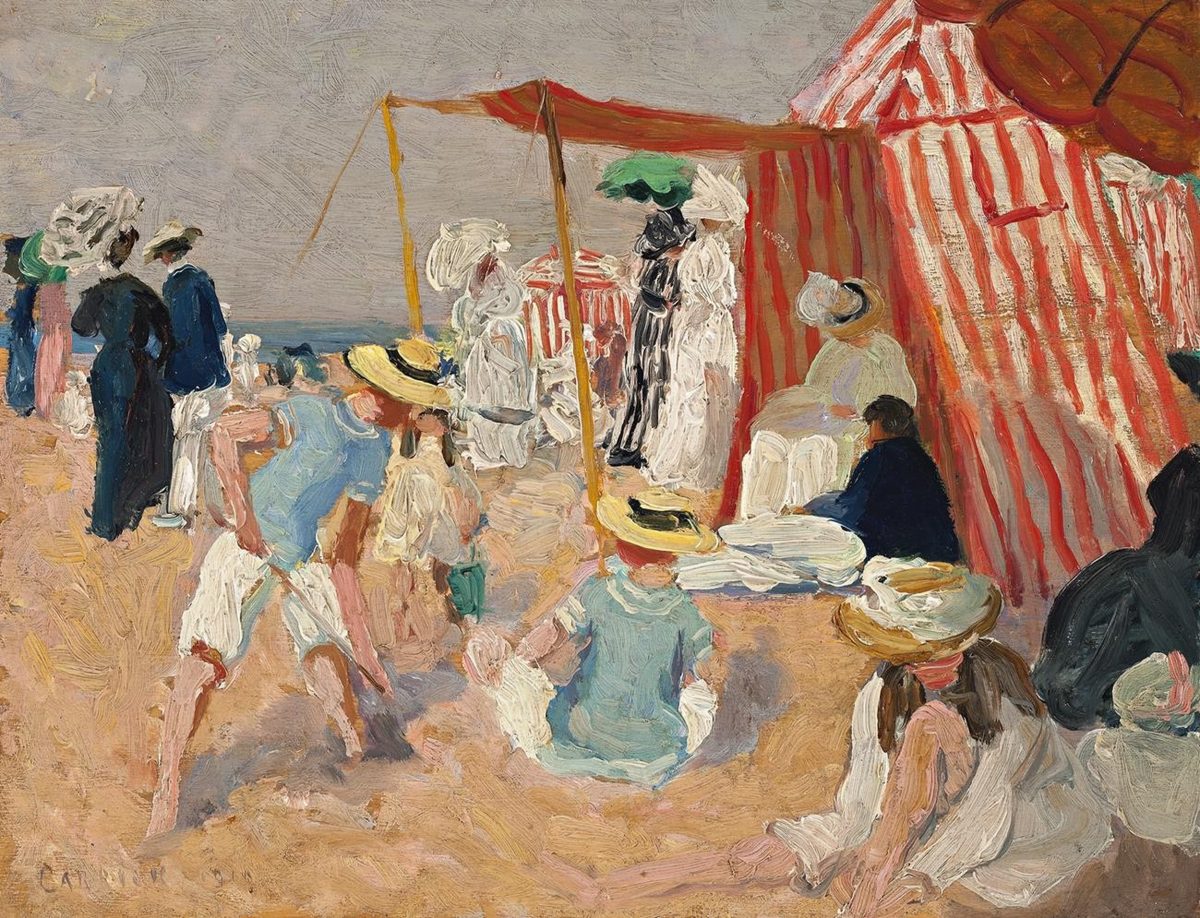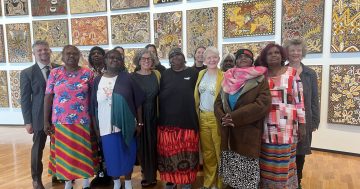
Ethel Carrick, Christmas Day on Manly Beach, 1913, also known as Manly Beach—summer is here, Manly, Manly Art Gallery & Museum Collection. Photo: NGA.
Ethel Carrick (1872-1952) and Anne Dangar (1885-1951) were two modernist artists who had links with Australia. They are now being honoured with huge separate retrospective exhibitions at the National Gallery of Australia.
The word ‘definitive’ is somewhat overused in writing about art exhibitions, but these shows, with over 300 exhibits, I would term definitive with virtually every major work by these artists assembled. The material has been comprehensively researched over five years by the two curators, Deborah Hart and Rebecca Edwards, and two very substantial books have been published to accompany the exhibitions.
These are not drawcard exhibitions featuring huge names with loads of visual candy but present some of the building blocks of Australia’s cultural identity. These are the sort of exhibitions that should be mounted by the National Gallery whereby, examining the somewhat neglected artists of the past, we come to understand our art of the present.

Ethel Carrick, Esquisse en Australie (Sketch in Australia) 1908, National Gallery of Australia, Kamberri/Canberra, Purchased 2023. Photo: NGA.
Carrick was English, born in Uxbridge, Middlesex, and trained in London where, while studying at the Slade School of Art, she met the Australian painter Emanuel Phillips Fox, an artist some seven years her senior. They married in 1905 and moved to Paris with occasional visits to Australia. Although Carrick’s health was fragile, her husband died unexpectedly in 1915 when it was discovered that he had cancer.
For the remaining 37 years of her life, Carrick devoted herself to promoting her husband’s legacy and travelling widely, painting and exhibiting. Like many of her generation, she adopted the pseudo-spiritual belief system of theosophy and sought solace in travel and art.
Post-Impressionism and modernism are somewhat nebulous terms that generated much passion in the first half of the 20th century. When we examine the 140 paintings and prints by Carrick assembled in this incredible exhibition, including her very early and spirited Esquisse en Australie [Sketch in Australia], 1908, or the well-known classic, Christmas Day on Manly Beach, 1913, or her Sur la plage [On the beach], 1910, it is evident that she adopted a brighter palette, a loose handling of the brush creating a choppy and broken surface, and chose more democratic and popular subject matter than that which was popularly accepted in Australian art at the time.

Ethel Carrick, Sur la plage (On the beach) 1910, private collection. Photo: NGA
Her paintings did attract attention in Australia and back in Europe. For her subject matter, Carrick was an artist in love with crowds – beach scenes, her beloved flower markets that she must have painted scores of times as she travelled in Europe, Australia, Northern Africa and India, as well as boats and shorelines.

Ethel Carrick, Flower market, Nice, c 1926, Art Gallery of New South Wales. Photo: NGA
Carrick’s Morning in Kairouan, c 1919–20, and Flower Market, Nice, c 1926, are among her strongest paintings in the exhibition. Her style did not particularly change over her half-century career and some of her early paintings that looked so radical early in her life contrast with her flower pieces of the 1940s and appear somewhat tame and conservative in the context of the contemporary Australian moderns.

Ethel Carrick, Morning in Kairouan c 1919–20, University Art Collection, Chau Chak Wing Museum, The University of Sydney. Photo: NGA.
Dangar was Australian born, she came from Kempsey, NSW, but spent most of her life in France. She was close to the Sydney artist Grace Crowley for most of her life and found her main artistic outlet in pottery. Danger was drawn to Cubism, but it was not to the first wave of heroic Cubism associated with such artists as Picasso, Braque and Gris, but the second, less well-known and less highly considered, associated with André Lhote and Albert Gleizes.

Anne Dangar, Plate with cubist design, 1932–33, National Gallery of Australia, Kamberri/Canberra, bequest of Michael Fizelle 1985. Photo: NGA.
She became a disciple of Gleizes and, in 1930, permanently moved to his artist colony, Moly-Sabata, in France. Dangar’s ceramic pieces from the early 1930s, including her Plate with cubist design and Coffee pot with lid, both from 1932-33, are startling works in which cubist designs are interpreted on plates, jugs and pots.
Many of her pieces are not widely known and I was personally surprised by the scale of some of the work – it is enormous – and the tight curatorial approach, matched Carrick’s designs with the finished ceramic pieces. Her work is an unexpected revelation – bold, clever and sensuously beautiful.

Anne Dangar, Coffee pot with lid, 1932-33, National Gallery of Australia, Kamberri/Canberra, gift of Grace Buckley in memory of Grace Crowley, 1982. Photo: NGA
Carrick and Dangar’s links to Australia are broken and, at times, indirect. These wonderful exhibitions present portraits of two artists who may have never met in real life but who have been posthumously united and, in their own ways, impacted the course of 20th-century Australian art.
Ethel Carrick | Anne Dangar is open at the National Gallery of Australia, Parkes Place East, Parkes, daily from 10 am to 5 pm until 27 April 2025. Entry is free.





















